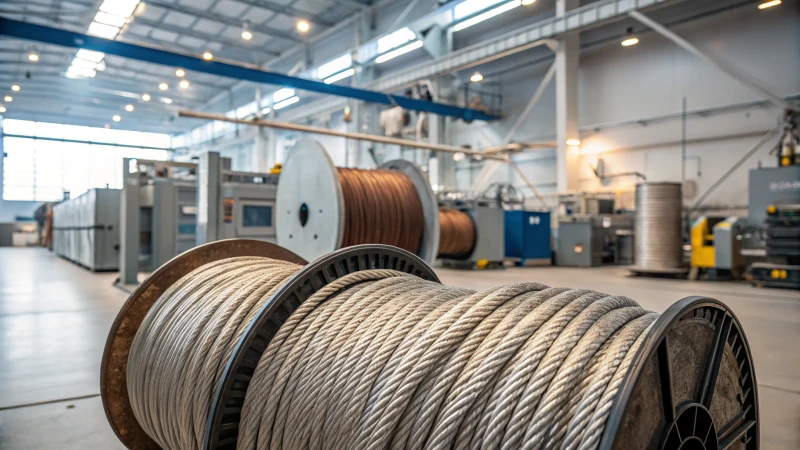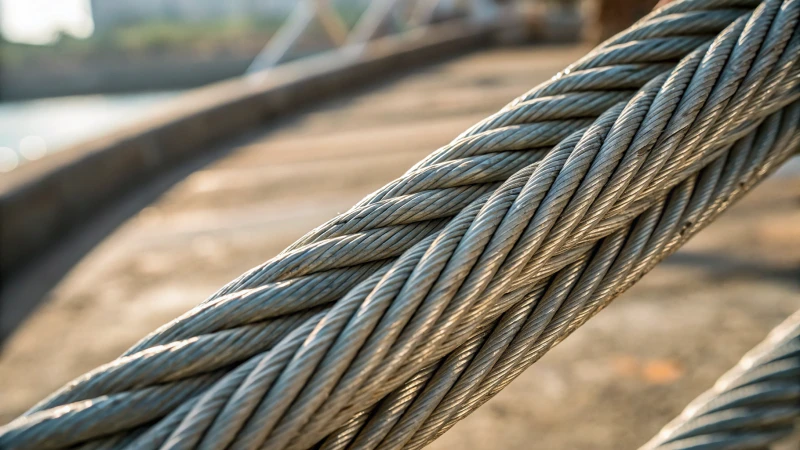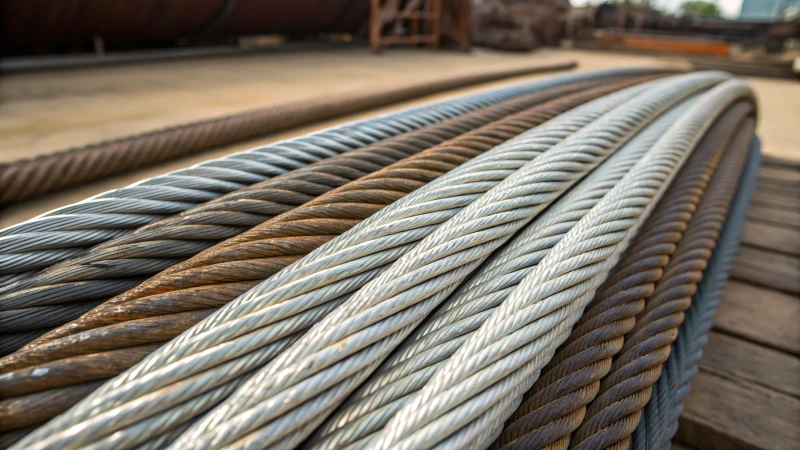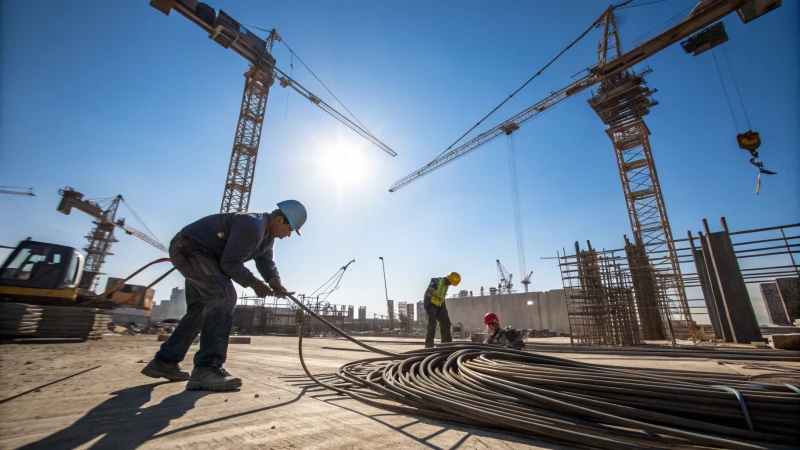
Have you ever wondered how a simple steel wire rope can carry tons of weight effortlessly?
Steel wire ropes are incredibly strong, with their strength influenced by construction, material, and diameter. For heavy tasks like mining and lifting, high tensile strength is crucial, while marine uses demand corrosion-resistant coatings, which might slightly lower strength.
I remember the first time I saw steel wire ropes at work during a construction project. Watching them hoist enormous steel beams into the sky was awe-inspiring. It got me thinking about the factors behind their incredible strength. Depending on what they're made from and how they're constructed, these ropes can tackle anything from mining to offshore drilling. They are true workhorses, tailored to meet the specific demands of different environments. Understanding these nuances can really make a difference when selecting the right rope for your needs.
Steel wire ropes are used in offshore drilling.True
Steel wire ropes provide necessary strength and durability for drilling.
Corrosion-resistant coatings increase steel rope strength.False
Coatings prevent corrosion but may slightly reduce tensile strength.
What Factors Influence the Strength of Steel Wire Rope?
When I first learned about steel wire ropes, I was amazed by how many factors can influence their strength.
The strength of steel wire rope depends on its construction, material composition, diameter, and environmental conditions. Each aspect uniquely impacts its tensile strength, flexibility, and durability, making the right choice crucial for your specific needs.

Rope Construction
The design and construction of steel wire rope significantly impact its strength and durability. Key aspects include the number of strands, the number of wires per strand, and the type of core used. For example, a strand core1 provides flexibility, while an independent wire rope core enhances strength. Different lay patterns like regular or lang lay affect how the rope handles wear and tension.
I remember working on a project where the type of core in our steel wire rope made all the difference. We needed something flexible yet strong enough to handle intense loads. That's when I realized the importance of choosing between a strand core for flexibility or an independent wire rope core for enhanced strength.
Material Composition
The type of steel used in manufacturing wire ropes plays a critical role in determining its strength. High-carbon steel offers excellent tensile strength, while stainless steel provides superior corrosion resistance, essential for marine applications. Coatings such as galvanization further enhance durability by protecting against rust.
| Material Type | Features |
|---|---|
| High-carbon steel | High tensile strength |
| Stainless steel | Corrosion resistance |
| Galvanized steel | Rust prevention |
Deciding on the right material for our ropes was a bit like choosing the perfect shoe. High-carbon steel offers that incredible tensile strength, almost like wearing a solid hiking boot, while stainless steel is like your trusty rain boots—excellent against corrosion, especially for marine applications.
Diameter and Load Capacity
The diameter of the wire rope is directly proportional to its load capacity. Larger diameters offer higher breaking strengths but may compromise flexibility. For instance, a 12 mm diameter rope will have a higher load capacity compared to an 8 mm rope but might be less flexible, influencing its application in flexible systems2.
Once, we opted for a 12 mm rope thinking bigger meant better load capacity, only to find out it was less flexible than the 8 mm we previously used. This experience taught me that while larger diameters boost breaking strengths, they might also reduce flexibility—a critical consideration depending on whether you're using flexible systems.
Environmental Conditions
Environmental factors like humidity, temperature, and exposure to chemicals can degrade the strength of steel wire ropes. In offshore or industrial settings, ropes often require protective coatings or treatments to withstand harsh conditions. The use of corrosion-resistant alloys3 can maintain performance over time by minimizing the effects of environmental stress.
The environment can be a silent but fierce adversary to steel wire ropes. I recall a scenario where exposure to harsh chemicals demanded we choose ropes with protective coatings.
Application-Specific Requirements
Different applications demand varying characteristics from steel wire ropes. For mining operations, ropes need to endure abrasive conditions and handle heavy loads; in construction tasks like lifting they must offer a balance between strength and flexibility.
Understanding these application-specific needs can guide you in selecting the most suitable rope for your project4.
Each factor mentioned plays a pivotal role in shaping the performance and reliability of steel wire ropes across diverse industrial applications.
A strand core enhances the strength of steel wire rope.False
A strand core provides flexibility, not strength, unlike an independent wire rope core.
High-carbon steel offers high tensile strength for wire ropes.True
High-carbon steel is known for its excellent tensile strength, making it ideal for durable wire ropes.
How do coatings influence the performance of steel wire ropes?
Ever wondered why steel wire ropes shine in some projects but not in others? It might just be the coating.
Coatings on steel wire ropes are crucial for enhancing corrosion resistance, extending lifespan, and maintaining tensile strength, especially in harsh environments. With options like galvanized, plastic, and alloy coatings, each brings unique benefits tailored to specific needs and applications.

Corrosion Resistance
When I first dove into the world of steel wire ropes, I quickly learned that the secret to their durability lies in their coating. Picture this: you’re standing at a construction site, the salty ocean breeze brushing against your face, knowing that your project hinges on those ropes. A galvanized coating here is like a suit of armor, with zinc forming a protective barrier against rust. It's that layer of security that I’ve come to rely on in demanding environments.
| Coating Type | Corrosion Resistance | Tensile Impact |
|---|---|---|
| Galvanized | High | Minimal |
| Plastic Coated | Moderate | Variable |
| Alloy Coatings | Superior | Maintains |
Tensile Strength
The balance between protection and strength is a delicate one. I remember grappling with this trade-off on a project where we used galvanized ropes. Sure, it meant compromising a bit on tensile strength (by 5%-15%), but the peace of mind from enhanced corrosion resistance was worth it. Opting for high-performance alloys5 can help strike that perfect balance, ensuring that strength isn’t sacrificed for safety.
Environmental Suitability
Different coatings excel in different environments. Think of offshore projects as the Everest of challenges for ropes. There, stainless steel or specialized coatings are non-negotiable. I’ve seen first-hand how these choices can make or break a project—literally! In mining, we leaned towards galvanized or alloy-coated ropes, which offer a blend of resilience and durability.
- Mining Operations: Typically lean towards galvanized or alloy-coated ropes for their strength and corrosion resistance.
- Offshore Projects: Favor specialized alloy or stainless coatings to fend off marine threats.
For any project you embark on, weighing environmental conditions and load requirements is key. Whether you’re like me, always learning from every project, or someone who’s been around the block, consulting with experts can shed light on the perfect coating choice for your specific needs.
Galvanized coatings reduce tensile strength by 5%-15%.True
Galvanized coatings provide corrosion resistance but slightly reduce tensile strength.
Plastic coatings offer superior corrosion resistance.False
Plastic coatings provide moderate corrosion resistance, not superior.
How do High-Strength Steel Wire Ropes Transform Industries?
Let me share with you why high-strength steel wire ropes are the unsung heroes in many demanding industries.
High-strength steel wire ropes are indispensable in industries like construction, mining, and marine. Their durability and ability to handle extreme conditions make them essential for safety and efficiency in these sectors.

Construction Industry
When I think about the role of high-strength steel wire ropes in construction6, I can't help but remember the first time I stood beneath a massive crane, watching it effortlessly lift heavy beams into place. It was a moment of awe and realization that these ropes are the backbone of construction sites. They ensure not only that materials are moved safely but also that projects stay on schedule. The ropes' enhanced load capacity and durability reduce the risk of accidents, making them a staple on every construction site.
Benefits:
- Enhanced Load Capacity: Handles heavy weights effortlessly.
- Safety Assurance: Significantly reduces accident risks.
- Durability: Withstands wear and tear over time.
Mining Sector
In mining7, I've seen firsthand how critical it is to have equipment that can endure the harshest conditions. High-strength steel wire ropes are essential for hoisting systems in mines. These ropes must withstand not only extreme weight but also corrosive environments underground. They're the unsung heroes that keep operations running smoothly and safely.
Key Advantages:
- Resistance to Corrosion: Perfect for tough underground conditions.
- High Tensile Strength: Supports heavy lifting with ease.
- Longevity: Minimizes the need for frequent replacements.
Marine and Offshore Operations
I've always been fascinated by marine operations—whether it's watching a ship being moored or an oil rig standing strong against relentless waves. Steel wire ropes are pivotal in these settings due to their strength and corrosion resistance in saltwater. They’re like the lifeline of the sea, keeping everything secure and functioning.
Notable Features:
- Corrosion Resistance: Vital for marine applications8.
- Flexibility and Strength: Adapts to dynamic marine environments.
- Temperature Resilience: Performs well across various climates.
Industrial Manufacturing
In industrial settings, I've seen how machinery's efficiency often hinges on the strength and flexibility of steel wire ropes. These ropes keep everything from conveyors to cranes moving seamlessly, which is crucial for maintaining productivity and minimizing downtime.
Advantages in Industry:
- Versatility: Fits a wide range of machinery.
- Strength Retention: Holds its integrity under stress.
- Cost-effectiveness: Long lifespan translates to lower costs over time.
| Industry | Key Application | Benefits |
|---|---|---|
| Construction | Cranes & Hoists | Load capacity, safety, durability |
| Mining | Hoisting Systems | Corrosion resistance, tensile strength |
| Marine & Offshore | Mooring & Towing | Corrosion resistance, flexibility |
| Industrial | Machinery Lifting | Versatility, strength retention |
Embracing these strengths allows industries to operate more efficiently and safely, making high-strength steel wire ropes a cornerstone of modern industrial practices.
Construction sites rely on steel wire ropes for crane operations.True
Steel wire ropes are essential in construction cranes for lifting heavy materials.
Marine operations prefer nylon ropes over steel wire ropes.False
Marine operations favor steel ropes for their strength and corrosion resistance.
What Are the Latest Innovations in Steel Wire Rope Technology?
Have you ever marveled at the strength and flexibility of steel wire ropes, wondering what makes them so indispensable across industries?
Innovations in steel wire rope technology now include advanced materials, corrosion-resistant coatings, and smart monitoring systems. These improvements enhance the durability and safety of wire ropes, making them more efficient and reliable for various industrial applications.

Advanced Materials and Alloys
I remember the first time I encountered super duplex stainless steel during a site visit. The engineer showed me how its enhanced strength and corrosion resistance9 were pivotal for offshore operations. These high-performance alloys are truly revolutionizing our approach, ensuring that steel wire ropes can withstand the harshest environments without compromising on tensile strength.
Smart Monitoring Systems
Imagine ropes that can communicate! During a project, I was introduced to smart monitoring systems embedded within steel wire ropes. These sensors gather real-time data on tension and wear, allowing for predictive maintenance. It's like having a sixth sense for your equipment, drastically reducing downtime and enhancing safety. To grasp the full potential of smart monitoring technology10, you need to see it in action.
| Feature | Benefit |
|---|---|
| Real-time data analysis | Predictive maintenance |
| Enhanced safety | Reduced downtime |
| Cost-effective solutions | Extended rope lifespan |
Sustainable Coatings and Treatments
Sustainability is a buzzword we hear a lot these days. But when I discovered zinc-aluminum coatings on steel wire ropes, I realized their potential. They offer superior corrosion protection and are kinder to the environment, extending rope longevity for sustainable projects11 without compromising our planet's health.
Customization and Adaptability
There was this one construction project where I saw customized steel wire ropes tailored precisely to the task at hand. It was fascinating how different diameters, construction types, and coatings could be optimized for specific applications, from marine to industrial use. This level of customization12 ensures that ropes perform optimally under diverse conditions.
The Role of Nanotechnology
Nanotechnology might sound like science fiction, but it's here, enhancing our steel wire ropes with improved abrasion resistance and reduced friction. I recall a conference where experts discussed how nanocoatings significantly extend the lifespan of these ropes. The ongoing research into nanotechnology applications13 is pushing boundaries I never thought possible.
These innovations are not just about meeting today's challenges; they are about envisioning a future where industries reliant on steel wire ropes can explore new possibilities with confidence and creativity.
Super duplex stainless steel enhances rope durability.True
Super duplex stainless steel offers superior corrosion resistance and strength.
Nanotechnology reduces the lifespan of steel wire ropes.False
Nanotechnology improves abrasion resistance, extending rope lifespan.
Conclusion
Steel wire ropes exhibit exceptional strength influenced by construction, material, and diameter, making them essential for various applications like mining, construction, and marine operations.
-
Discover how a strand core enhances flexibility in wire ropes. ↩
-
Learn why flexibility matters in systems requiring frequent bending. ↩
-
Find out which alloys provide superior corrosion resistance. ↩
-
Explore considerations for selecting wire ropes tailored to specific projects. ↩
-
High-performance alloys can maintain tensile strength while providing superior corrosion resistance in harsh environments. ↩
-
Explore how steel wire ropes enhance safety and efficiency in construction projects. ↩
-
Learn how steel wire ropes improve mining operations by providing strength and durability. ↩
-
Understand the role of steel wire ropes in marine environments and their benefits. ↩
-
Explore how high-performance alloys enhance steel wire rope durability and corrosion resistance in demanding environments. ↩
-
Discover how smart monitoring systems increase safety by providing real-time data on rope conditions. ↩
-
Learn about eco-friendly coatings that offer superior corrosion protection while reducing environmental impact. ↩
-
Find out how customization in wire ropes meets specific industrial needs for optimal performance. ↩
-
Understand the role of nanotechnology in enhancing the strength and durability of steel wire ropes. ↩

